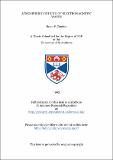Files in this item
Atmospheric guiding of electromagnetic waves
Item metadata
| dc.contributor.advisor | Maitland, Arthur | |
| dc.contributor.author | Condon, Brian P. | |
| dc.coverage.spatial | 158p, 11p of plates. | en_US |
| dc.date.accessioned | 2018-06-14T08:46:49Z | |
| dc.date.available | 2018-06-14T08:46:49Z | |
| dc.date.issued | 1993-07 | |
| dc.identifier.uri | https://hdl.handle.net/10023/14037 | |
| dc.description.abstract | We propose to alter the propagation conditions experienced by a microwave beam by the generation of a "laser beam atmospheric waveguide". The waveguide is formed by tailored refractive index changes caused by the absorption of a small part of the energy of an annular laser beam. The objective is to increase the microwave radiation field experienced by a target through improved directionality rather than total radiated power from the source. The equations governing the propagation of high power laser beams in the paraxial limit and their interactions (both linear and non-linear) with an absorbing atmosphere are derived and studied. The mechanisms which lead to the formation of the guide and the effects of the propagation environment are considered in detail and the full paraxial form of the thermal blooming wave equation is derived from first principles. Refractive index changes in air caused by the passage of a 1 kW CW CO2 Gaussian laser beam are studied theoretically and both linear and non-linear cases examined. In the linear case, it is predicted that the laser beam produces a refractive index change of greater than 1 part in 10<super> 5</super> for a 1 second beam exposure. In the non-linear case, the iterative scheme developed predicts self-interaction and beam break-up after less than 0.5 s. For an annular beam, refractive index changes of 3 parts in 10 are predicted for the linear case. The influence of refractive index fluctuations on microwave radiation is modelled using a ray-tracing algorithm to investigate the behaviour of microwave radiation in an atmospheric waveguide. For a step-index guide of 5 cm radius, there is strong guiding so that even with a small perturbation in refractivity, rays with a wide range of launch angles are trapped. In the case of a guide with a quadratic refractive index profile, small changes in refractive index (1 part in 10<super>6</super>) produce weak guiding where only rays with trajectories very close to the optic axis are trapped. As the refractive index change increases, more divergent rays are trapped until a transition to strong guiding occurs at a critical value (changes in refractive index of the order of 1 part in 10<super>4</super>). A number of implementations of the waveguiding concept are proposed and evaluated. For the purposes of an experimental verification, a specially designed Annular Beam Director ("ABD") of an on-axis type is tested. Annular laser beams are propagated over short distances in the laboratory and the results presented. Measurements made with a rotating wire laser beam analyser indicate that the ABD performs well. Experiments designed to measure refractive index changes caused by a 1 kW CW CO2 laser beam of Gaussian profile are described. Measurements are made at wavelengths of 633 nm using a specially configured Michelson interferometer and at 3 mm using a millimetre wave quasi-optical FM noise measurement system. Typical results indicate refractive index changes of the order of 1 part in 106 at both the wavelengths considered. The guiding of microwave radiation is verified using a 1 kW CW CO2 annular laser beam, produced by the ABD, into which microwave energy is injected using a small copper reflector located at the centre of the annulus. In one implementation, the microwave energy is coupled out of the guide with a second copper reflector. In a second implementation, the microwave detector imit is located on the optic axis and the laser beam is terminated in an annular beam dump. The results show clear evidence that the high power laser beam forms a waveguide, increasing the amount of microwave radiation reaching the detector by a factor of 1.5. | en_US |
| dc.language.iso | en | en_US |
| dc.publisher | University of St Andrews | |
| dc.subject.lcc | TK7871.65C7 | |
| dc.title | Atmospheric guiding of electromagnetic waves | en_US |
| dc.type | Thesis | en_US |
| dc.type.qualificationlevel | Doctoral | en_US |
| dc.type.qualificationname | PhD Doctor of Philosophy | en_US |
| dc.publisher.institution | The University of St Andrews | en_US |
This item appears in the following Collection(s)
Items in the St Andrews Research Repository are protected by copyright, with all rights reserved, unless otherwise indicated.

